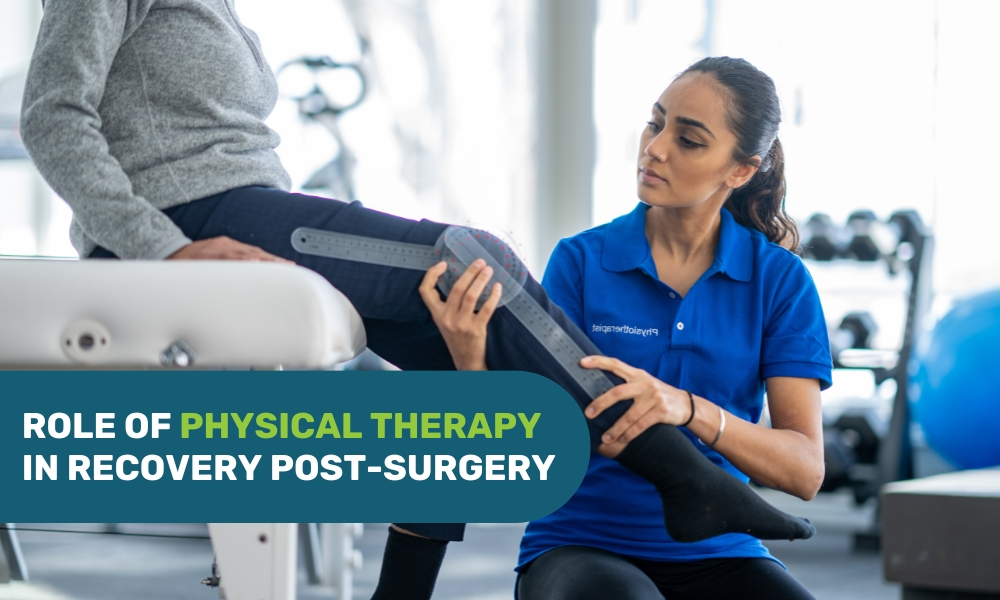The steps an individual takes after an operation impact their recovery. Physical therapy or physiotherapy is a treatment that helps patients regain mobility and function and speeds up the healing process after a surgical procedure.
Who should take Physiotherapy?
Physiotherapy is suitable for patients who undergo a wide range of medical operations or procedures like:
-
Knee or Hip surgery
-
Wrist surgery
-
Back surgery
-
Joint replacements
-
Shoulder surgery
-
Bypass surgery
-
Pelvic organ surgeries
-
ACL & meniscus tears
Patients need to take physical therapy post-surgery for better recovery. Here are eight impressive benefits of physical therapy post-surgery for patients of all ages and stages of life.
-
Addresses pain and inflammation naturally. After most operative procedures, patients experience soreness. Physical therapists have several techniques to reduce post-operative pain, stiffness, and inflammation.
-
Strengthens the body after surgery. Muscle strength is essential for our body’s overall health and wellness. The affected area and structure surrounding the injury are generally weak, especially in the case of an individual living with an injury for a while or someone who has had surgery to repair an injury. Physiotherapists are trained to understand what type of exercise each tissue (muscles, ligaments, tendons) needs to be its strongest and heal quickly. Strategic exercise under the guidance of a trained physiotherapist helps the patient regain strength at the surgical site and throughout the body.
-
Improves balance and control. Physical therapy plays a vital role in the case of joint-replacement surgery. In the case of hip or knee replacement, a patient has to relearn how to walk or move well with their new hardware. Physiotherapy improves the balance and stability of patients after surgery, helping patients to walk, jump, jog, or bike again with confidence. Balance exercises help reduce the possibility of re-injury in post-operative patients.
-
Helps scar tissue become more pliable. Scar tissue comprises cells and collagen covering the site of injury. It forms when normal tissues are damaged by disease, injury, or surgery and is the body’s natural way of trying to replace and heal damaged areas. The development of a scar is part of a healing process. The formation of a scar can impede flexibility, movement, and strength around the surgical site. With the help of physical therapy, the tissues and scars can become smooth and pliable, allowing the limbs to move freely.
-
Increases mobility and flexibility. Reducing dense scar tissue is one-way physical therapy helps improve patients’ mobility and flexibility. Massage, myofascial release, and manual manipulation are physiotherapy methods designed to increase the range of motion after an invasive procedure. Physical therapy aims to achieve pain-free and smooth movement in patients.
-
Allows patients to safely resume physical activity. Any type of high-intensity activity after joint replacement or other major surgery can be hazardous and may even impact healing. However, exercise is equally essential after an operation. But it needs to be done under expert guidance, and safety measures should be followed. In physical therapy, light exercises are introduced so that the healing process is not disrupted, lowering the risk of complications.
-
Promotes healing. Sometimes, surgery becomes the right decision in certain medical situations for an individual’s health and wellness, but surgery is still stressful for the body. The body responds post-operation according to certain physiological changes, called the surgically induced stress response. Physical therapy helps an individual recover from such stress and encourages healing. Through manual therapy, exercise, and other techniques, physiotherapy aims to increase blood flow to the surgical area and across the body, thereby reducing inflammation and promoting recovery.
Staying immobile for too long after a procedure may decrease muscle strength, reduce mobility, and affect the normal functioning of vital organs like the heart and lungs. Physical therapy or physiotherapy prevents this through safe and assisted movement in a controlled environment. Physiotherapy can help an individual resume their normal life post-surgery. To book a Physiotherapy from the comfort of your home, CLICK HERE.





